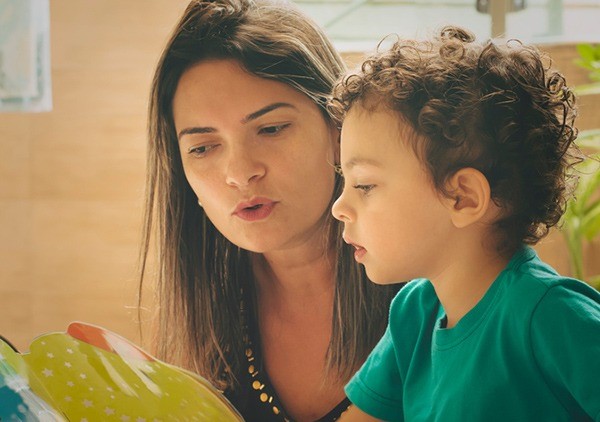- 855.224.8655
- Schedule a Tour

Reading to infants and toddlers is a great way to develop emergent literacy skills and build an interest in books. Parents and caregivers are a vital component of the child’s experience with reading and language. Learn how to make reading an engaging and fun activity in your infant or toddler’s daily routine.
Why You Should Read to Your Children
At the infant and toddler stages, children are developing early literacy or pre-reading, skills. When children are exposed to a language-rich environment, their language skills develop accordingly. Young children learn many things when you read to them, like:
- Pictures and words have meaning.
- New words are everywhere.
- Rhythm and rhyme are fun.
- Reading time is cozy and loving.
- Books have stories that I can hear over and over again.
Reading to Baby: Start Early
Foster a love for reading as soon as possible! Young infants may happily listen to your voice for however long you want to read, as long as their other needs are met. This is a great opportunity to bond with your infant, so make it a regular part of their routine.
At this age, it’s important to have appropriate baby books on hand. Older infants may only be interested in books if the textures and images on the pages catch their attention. Books with bright colors are ideal for keeping them interested.
Remember that babies explore their surroundings by mouthing objects, so don’t worry if a fascinating book goes right into baby’s mouth. As your infant is going through this stage, opt for chewable books.
By about 12 months, babies will begin to engage with what you’re reading. They may repeat the sounds you say, or point to the objects that they recognize. Allow them to guide story time, and pay attention to what interests them as you read together.
Reading to Toddlers: Let Them Set the Pace
Toddlers can take a more active role in reading. Pop-up books are perfect for this age because toddlers can now flip the pages and lift the flaps themselves. Don’t worry if a few pages get skipped. The point is to be familiar with how books work and to learn that they are interesting and fun.
Don’t expect toddlers to have long attention spans. It’s okay to cycle through books quickly without finishing each story, and it’s fine to move on to other activities as soon as children lose interest.
Older toddlers may love to read the same book many times, or stick to just a few different books on the same topic, such as ballerinas, firetrucks or baby animals. Children are forming a connection with books and the topics, which is one of the reasons you introduced reading in the first place.
6 Ways to Expand Your Children’s Reading Experience
It’s important to encourage reading early and often no matter how old your children are. Here are some ideas to enhance their love and excitement for reading.
- Choose a variety of books with different textures and vivid colors.
- Change your voice to match the character or tone of the book.
- Keep age-appropriate books accessible and at children’s eye level.
- Read books with predictable elements, such as stories that rhyme or that use a lot of repetition.
- Make your own books (older toddlers can help with this) using pictures of familiar people, places, animals, toys or colors.
- Read books that you can use simple sign language, such as Brown Bear, Brown Bear.
At U-GRO Learning Centres, we emphasize learning across all developmental domains, including language and literacy.
